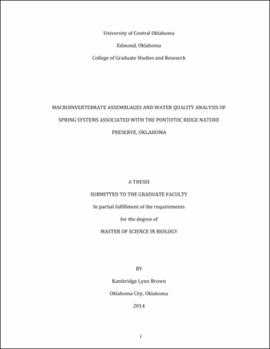| dc.description.abstract | Pontotoc Ridge Nature Preserve is located in southeastern Pontotoc County, Oklahoma, 20.7 miles south of Ada. This area consists of 2,900 acres of assorted vegetation with several springs, all of which emerge from the Arbuckle-Simpson Aquifer. Three springs, two located within the Nature Preserve and one on adjacent property, were surveyed during this study. Aquatic macroinvertebrates and physiochemical data were collected on a seasonal basis, every three months, beginning January 2011 and ending January 2012. With the exception of 16 dissolved oxygen readings and six orthophosphate readings, the physiochemical data meet standards that support and allow for aquatic life. A total of 127,048 individuals, representing 114 taxa, were collected throughout the course of this study. Non-hexapods, included amphipods, copepods, isopods, molluscs, playhelminthes, nematodes, and various other taxa, were the dominant macroinvertebrates present. The amphipod, Hyallela Azteca complex, was the most numerous non-hexapod as well as the most numerous macroinvertebrate, having a total of 76,529 individuals. Hexapods, represented by collembolans, ephemeropterans, odonates, plecopterans, hemipterans, trichopterans, coleopterans, and dipterans, were more diverse in terms of taxa, with a total of 93 taxa collected and identified. Of the three springs studied, Smith Spring was the most diverse with an average of 44.8 taxa, followed by Canyon Spring with an average of 32.4 taxa, and Cave Spring with an average of only 21 taxa. Canyon Spring was the most populated (84,339 individuals), followed by Smith Spring (38,837 individuals), and Cave Spring (3,873 individuals). The April 2011 collection contained both the largest number of individuals, 34,368, as well as the highest number of taxa, 74, found. Similarity indices for combined collections between springs were similar, with the average indices above 0.425. Similarity indices for comparisons between upper and lower collection sites were lower, with average indices no greater than 0.349. Species diversity values were generally under 2.0, with a few exceptions in Cave Spring and Smith Spring, having averages no greater than 1.785. The results of this investigation indicate these springs are in nearly pristine condition and they play an important role in the Pontotoc Ridge ecosystem. | |
